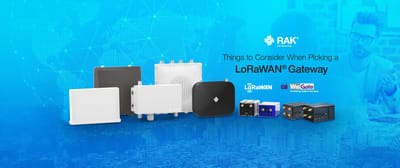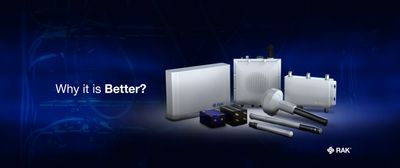Helium: Building the People’s Network with RAK
At RAKwireless, we are no strangers to low power, wide area networks (LPWAN), specifically LoRaWAN® protocol networks. We’ve seen this technology pick up speed since 2016, driven by a very active ecosystem ranging from hobbyists, integrators, and network operators all collaborating to provide coverage and an overwhelming range of sensor solutions. We are proud that RAK has been behind many of these developments and innovations since the beginning.
LPWAN network challenges
Of all the essential factors for a successful project, network coverage sits at the core – it’s the vital requirement that must be satisfied to deploy any LPWAN solution.
As of the first half of 2019, you could acquire LPWAN network coverage through one of three options: a commercial operator paying someone a site rental fee to host a LoRa® gateway and selling this connectivity; a company deploying gateways on their infrastructure as a private network; or a community platform–– like The Things Network–– where people can connect their gateways and provide coverage for free.
All three approaches have scalability problems: site rental contracts are tricky and time-consuming to negotiate, while private network deployments come with high operation and maintenance costs - on top of not providing direct extra income. Finally, free community networks heavily depend on skilled and altruistic people to keep the coverage in place. Without additional incentives most people find that managing a LoRaWAN® gateway becomes a chore and ultimately unplug, resulting in a lack of sustainability long-term.
Helium Network and its beginnings
Scaling things fast and building communities within complex licensing arrangements are problems the Helium team understands well. Shawn Fanning, one of Helium’s co-founders, launched Napster over 20 years ago. Napster created the first easy-to-use peer-to-peer network designed to exchange music, which went on to change the music industry forever in only two years, leading to the array of streaming options we have today.
Fast forward to the present, this same formula is being applied to Helium. The result is a crowdsourced, decentralized public network built for the Internet of Things (IoT) using peer-to-peer technology and complemented with a modern reward system built around a new kind of cryptocurrency, the Helium Token (HNT).
In simple terms, Helium hotspot owners deploy a small, low-power hotspot – similar to a Wi-Fi gateway - which gives any LoRaWAN-compatible node within radio range (typically one to 5 miles) access to the network. Sensors consume Data Credits to send data, which in turn are funded by Helium tokens (HNT). In return for adding coverage and carrying this sensor data, the Hotspot owner gets rewarded in Helium tokens, which can then be traded as any crypto in one of the supported exchanges (e.g. Binance US, HeliumEx, Bilaxy, and more to come).
More importantly, all of this technology has been packaged into an extremely easy-to-use interface in the form of a friendly mobile app. Helium hotspot owners don’t need any technical knowledge of LoRaWAN networks or blockchain. They simply deploy a gateway and start earning tokens rewards with a few easy steps on the mobile app. However, for enthusiasts and experts, the option to dig deeper and learn more via the open-source DIY route is available.

Is the formula working? In little more than a year, Helium patrons have deployed over 9000 gateways in over 1500 cities worldwide, which makes it the fastest-growing public LoRaWAN network ever, and there are no signs of it slowing down.

How does Helium work?
Helium runs on top of a custom-built blockchain that handles security, microtransactions, and packet routing. Blockchain is a name given to distributed ledgers designed to be tamper-proof and managed through a peer-to-peer network with no central server computers; this means high reliability–– as there isn’t a single server to go “down”–– and transparency. All participants can monitor the complete list of transactions that make up the ledger without changing what’s already there. Anyone can trace the history of the Helium blockchain back to the very first transaction.

Inside all Helium mining, capable gateways like our RAK Hotspot Miner sit two main software components: a LoRa® packet forwarder and the Miner.
The LoRa packet forwarder is the component common to all LoRaWAN gateways, which deals with the radio in the front-end. It receives data from the LoRa radio, packages it into a format useful for the Miner, and processes any scheduled transmissions within the scheduled times, such as configuration commands to the nodes or proof of coverage transmissions.
The Miner is the component connecting the LoRa packet forwarder to the Helium blockchain. It has three main tasks. Firstly, it manages its local copy of the distributed ledger, which all gateways on the Helium network keep participating in the blockchain. This copy is kept up to date and validated by constant communication with several network peers over the Internet using the Helium Consensus Protocol.
The second Miner task is routing. When a LoRaWAN message arrives from a sensor device, the Miner queries the blockchain for the corresponding server router number(s) (called an OUI in Helium-speak) associated with that device. The Hotspot then forwards the received message to the target router as specified in the blockchain. These routers can be Helium-owned – as is the case when the device is using the Helium console, or third-parties registered on the blockchain. The router is then responsible for handling the message payload and remitting payment to the Hotspot using Data Credits.
Finally, the third task for the Hotspot Miner is constructing and submitting proof of coverage (PoC) evidence, which gives confidence to the Helium network about the actual physical location of the Hotspot. Hotspots that submit the best location proofs with a larger number of verifications are more likely to be selected to a consensus group responsible for verifying transactions and mining blocks.

How did RAK come to join forces with Helium?
As often in IoT, this is a story of having a great idea, the passion to develop it, and meeting the right people to help you.
Amir Haleem, Helium’s CEO and co-founder, was looking to develop a new product around LoRa. He had a deep understanding of these technologies and must have tinkered with nearly every gateway out there. RAK, in particular, caught his attention for offering an excellent combination of great performance and low cost.
In early 2019, Amir contacted Ken Yu, RAK’s CEO, via Alibaba and enquired about our ability to supply gateway concentrator modules in volume for the US market. This invitation was a slightly odd request as until then, the US market for LoRa gateways hadn’t been very active. Ken was intrigued but, only hours later, both were already exchanging details and technical suggestions.
From our contacts, we recognized Helium would become a groundbreaking service we definitely wanted to get behind but more importantly, Helium also saw in RAK a good partner with the right product and supply chain to deliver their idea.
You can learn more about the story behind the RAK Hotspot Miner on The Hotspot Podcast.
How do I join the Helium network?
While the descriptions above may sound complicated, joining the Helium network, adding coverage, and starting to earn tokens couldn’t be any easier!
Our RAK Hotspot Miner comes ready to use right out of the box. Just connect the antenna, power it up, and follow some simple steps in the Helium mobile app.
Order now at the Official RAK Online Store or from our US partner Cal-Chip Connected Devices.

RAK Hotspot Miner
RAK Hotspot Miners earn HNT when devices connect, and for validating wireless coverage delivered by peers. Using a system called Proof-of-Coverage, RAK Hotspot Miners earn more HNT when they're in range of other RAK Hotspot Miners, but need to be at least 300 meters apart.






